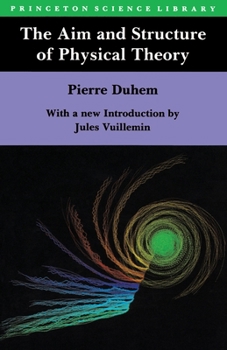The Aim and Structure of Physical Theory
Select Format
Select Condition 
Book Overview
This classic work in the philosophy of physical science is an incisive and readable account of the scientific method. Pierre Duhem was one of the great figures in French science, a devoted teacher, and a distinguished scholar of the history and philosophy of science. This book represents his most mature thought on a wide range of topics.
Format:Paperback
Language:English
ISBN:069102524X
ISBN13:9780691025247
Release Date:July 1991
Publisher:Princeton University Press
Length:344 Pages
Weight:0.05 lbs.
Dimensions:0.9" x 5.4" x 8.7"
Customer Reviews
2 ratings
Philosophy of science with a cheap history-facade
Published by Thriftbooks.com User , 16 years ago
"A physical theory is not an explanation. It is a system mathematical propositions, deduced from a small number of principles, which aim to represent as simply, as completely, and as exactly as possible a set of experimental laws." (p. 19). "[W]e recognize in a theory a natural classification, if we feel that its principles express profound and real relations among things," and thus "we shall not be surprised to see its consequences anticipating experience and stimulating the discovery of new laws." (p. 28). "It is not to [the] explanatory part that a theory owes its power and fertility; far from it. Everything good in the theory, by virtue of which it appears as a natural classification and confers on it the power to anticipate experience, is found in the representative part; all of that was discovered by the physicist while he forgot about the search for explanation. On the other hand, whatever is false in the theory and contradicted by facts is found above all in the explanatory part; the physicist has brought error into it, led by his desire to take hold of realities." (p. 32). An illustrative example is Descartes' work on optics. The "representative" part is quite flawless, while the explanatory part contains many silly things, e.g.: "Light is only an appearance; the reality is a pressure engendered by the rapid motions of incandescent bodies within a 'subtle matter' penetrating all bodies. This subtle matter is incompressible, so that the pressure which constitutes light is transmitted in it instantaneously to any distance" (p. 33). Indeed, Descartes was "the one who contributed most to break down the barrier between physical method and metaphysical method, and to confound their domains, so clearly distinguished in Aristotelian philosophy" (p. 43). He used the same principle in his physics, where he tried to prove that "all natural phenomena may be derived completely from this single proposition: 'The essence of matter is extension' ... He investigated the question of constructing the world with shape and motion by starting with this definition. And when he reached the end of his work, he stopped to contemplate it, and declared that nothing was missing in it: 'That there is no phenomenon in nature not included in what has been explained in this treatise'---so runs the title of one of the last paragraphs of the Principia Philosophiae." (p. 44). Newton used the right scientific approach (pp. 47-48), but his work was rejected by the Cartesians because of their garbling of science and metaphysics (pp. 15-16, 46-49). Newton won but "toward the end of the nineteenth century, hypothetical theories which were offered as more or less probable explanations of phenomena were extraordinarily multiplied. The noise of their battles and the fracas of their collapse have wearied physicists and led them gradually back to the sound doctrines Newton had expressed do forcefully." (p. 53). Theory-ladenness of experiment. "An experiment in physics is the preci
Compulsory reading for philosophers of science
Published by Thriftbooks.com User , 26 years ago
"The Aim and Structure" is a very influential book in the history of philosophy of science. Duhem rejects the methodology of crucial experiment and inductivism. He emphasizes that scientific experiments are not observations of raw empirical data, but they are highly dependent on theory (theory-ladenness of observation). But the most famous thesis of this book is epistemological holism; according to W.V.O. Quine it is a "milestone of empiricism". I consider "The Aim and Structure" an excellent introduction to some philosophical problems of science, a compulsory reading for a philosopher of science.






